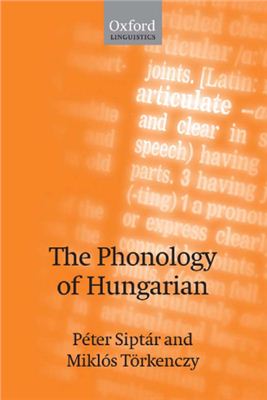The Phonology of Hungarian.
Author: P?ter Sipt?r and Mikl?s T?rkenczy.
OXFORD.
UNIVERSITY.
Publisher: Oxford University Press Inc. , New York.
Publication date: 2007.
ISBN: 978–0–19–922890–4.
Number of pages: 338.
This book presents a rule-based account of the phonology of Hungarian. At.
a time when current phonological research is undergoing a radical shift of.
emphasis towards non-derivational models (Declarative Phonology, Govement.
Phonology, Optimality Theory), this choice of framework calls for a.
brief comment. Our decision to use a derivational framework follows from.
our primary aims rather than our theoretical preferences. As (with the.
notable exception of vowel harmony) Hungarian phonology is relatively little.
discussed in the inteational literature, we wanted to cover as much.
ground as possible descriptively, and discuss the data in a manner which is.
coherent and yet transparent in the sense that it is readily accessible for phonologists.
of a wide range of theoretical affiliations and backgrounds. As the.
various non-derivational frameworks have very little in common and (some.
of) their (basic) assumptions are still in a state of flux, this has practically.
determined our decision. It is perhaps not surprising that while several.
(sometimes very complex) phenomena from various languages have been.
given non-derivational treatments, no comprehensive analysis of the sound.
patte of a single language has been published in any of these non-derivational.
theories.1.
Author: P?ter Sipt?r and Mikl?s T?rkenczy.
OXFORD.
UNIVERSITY.
Publisher: Oxford University Press Inc. , New York.
Publication date: 2007.
ISBN: 978–0–19–922890–4.
Number of pages: 338.
This book presents a rule-based account of the phonology of Hungarian. At.
a time when current phonological research is undergoing a radical shift of.
emphasis towards non-derivational models (Declarative Phonology, Govement.
Phonology, Optimality Theory), this choice of framework calls for a.
brief comment. Our decision to use a derivational framework follows from.
our primary aims rather than our theoretical preferences. As (with the.
notable exception of vowel harmony) Hungarian phonology is relatively little.
discussed in the inteational literature, we wanted to cover as much.
ground as possible descriptively, and discuss the data in a manner which is.
coherent and yet transparent in the sense that it is readily accessible for phonologists.
of a wide range of theoretical affiliations and backgrounds. As the.
various non-derivational frameworks have very little in common and (some.
of) their (basic) assumptions are still in a state of flux, this has practically.
determined our decision. It is perhaps not surprising that while several.
(sometimes very complex) phenomena from various languages have been.
given non-derivational treatments, no comprehensive analysis of the sound.
patte of a single language has been published in any of these non-derivational.
theories.1.

